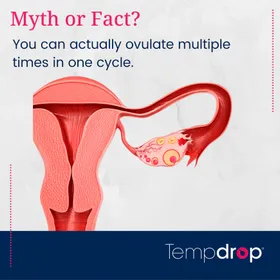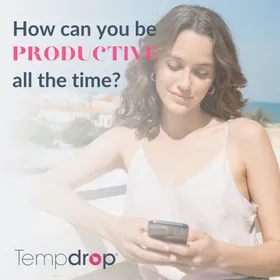How to Handle Fertility Charting When Traveling
Published February 5, 2025.

Travel can pose some challenges to fertility charting. As we set off for sun, sea and fun, we're providing some tips to help you navigate charting while traveling.
Overcoming Challenges to Tracking Basal Body Temperature (BBT)
If you do traditional BBT tracking, you may need to consider changed sleeping schedule and time zones. It's sometimes said that your body adjusts roughly one time zone per day, and for those on long flights across multiple time zones, such as Europe to Australia, that could mean an adjustment of a few days before your body settles into your new location.
Those traveling east may find the effects more prominent than those traveling west. When traveling across time zones (especially if you are flying versus driving), take note of the many suggestions out there for mitigating jet lag and try some of them! Also we put together a list of items we recommend to travel with, to help maintain your hormone health in our Instagram post.
Every body is unique and you know your body best. You may be able to temp immediately upon waking after their best sleep, no matter what the actual time, and your temping chart will be fine. On the other hand, you may need to ask yourself, "what time does my body think it is?" and then make any temperature adjustments (if your FABM method allows). For example Boston Cross Check allows for adjustments up to 90 minutes either side of your base temping time.
If adjusting your temp, keep a note of the original temp somewhere, in case you need to refer to it later. If adjustments are not possible, you can mark your temp as questionable or disturbed, and remember that when interpreting your chart.
However, if you are using a Tempdrop, no adjustments will be needed. The algorithms are not affected by time zones (just make sure you don't sync twice in the same day). Wear your Tempdrop for your longest period of sleep during travel. The dates on your phone will be based on the time zone of your most recent sync. If you are changing time zones it could temporarily affect the dates on the Tempdrop app but it will go back to normal after your first sync in your home time zone. You can set your phone to stay in your home time zone to avoid this potential issue.
Tempdrop uses a watch battery, so this will pose no problems for airport security. If you are away from cellular data or wifi connections for some time, know that your Tempdrop will hold up to 60 hours of data (equivalent to 7 x 8 hour sleep sessions)
Overcoming Challenges with Tracking Cervical Fluid
Cervical fluid should be observed in the same way you usually do.
If you use the wiping approach, be aware as you travel that changes to the type of toilet tissue used may affect your observations. Thick and fluffy paper, that tends to shred lint, may cause your observations to feel, or look, different to what you are used to.
Your body may react to colored or scented toilet paper, causing a discharge that could confuse your observations, and the color of the paper itself could affect visual observations. In some locations, such as South America, it can be hard to find non-scented toilet paper.
If you usually use 2 or 3 ply tissue and your accommodation provides 1 ply tissue, you may need to fold it up much more to replicate the sensation you're used to. Remember to carry toilet tissue in locations where it's not typically provided in public restrooms.
Making visual observations may be harder in travel restrooms with poor lighting quality, and especially challenging in camping outhouses with very limited lighting.
Make sure to stay reasonably well hydrated on long flights, or on tours or sporting activities, as dehydration could make it more difficult to read cervical fluid signs.
For methods that involve keeping tabs on sensation as you go about your day, being out of routine with the novelty or busy-ness of travel can sometimes mean you may forget to pay attention. For anyone who has that issue, you could try setting phone or watch reminders, or involving a travel partner for prompts.
Failing that, if you feel you may have missed something, you can note those days on your chart as being questionable and follow your method rules about how to handle it.
Overcoming Challenges to Tracking Hormones & Ovulation Testing
If you follow a sympto-hormonal method such as Boston Cross Check or Marquette, the Clearblue Fertility Monitor testing window of 6 hours is pretty generous. Between that and your collected sample’s “testing life span” of twelve hours, many people manage to test each day testing is indicated.
For example, if your testing window is 5:00 AM – 11:00 AM on the East Cost of the USA, and you travel to the West Coast of the USA, waking at 7am there each morning, you still have an hour to complete your test. (Your testing window there will be 2:00 AM – 8:00 AM.) Plenty of time! If you're traveling West Coast to East Coast, or further away, you might need to be more strategic. If you're aware of upcoming travel, you can set your testing window at the start of the cycle so that it will work for both time zones. This is the optimal solution.
With some monitors you can set it so your testing window simply fits your future destination time zone, and save your urine sample to test. For example, if you live in New York, USA and are traveling to Perth, Australia (thirteen-hour time difference) you simply set the monitor at the beginning of the cycle for the testing window to be where you want it to be when you’ll be in Perth. You might want your testing window to be 4:00 PM - 10:00 PM in New York time so that when you get to Perth you can test from 5:00 AM - 11:00 AM local time. You’ll need to collect your first morning urine sample and save it until the testing window opens in the afternoon or evening. Saving your urine? Your sample is generally considered good at room temperature for testing for twelve hours. If you'll be at an airport or train or bus terminal, you can take a small container with a secure lid to collect your sample there, if needed.
Ideally your monitor should be taken with you in your carry-on bag, as extremes of temperatures in the hold may adversely affect it. And you’ll want it with you – along with testing sticks - if your journey is long or you experience a travel disruption. Be sure to pack it securely. Don't place it with items that might leak and get it wet. When at your destination, if you are sharing a bathroom and privacy is a concern, you can get a lidded sample cup and whisk it to the bathroom to test. You may like to conceal it in your toiletries/cosmetics bag to avoid curious questions.
While collecting a sample and dipping the test stick for a timed 15 seconds is the recommended method of testing, there is also the option of using the stream (urinating directly on the test stick paper) for 3 seconds.
While traveling, you may find LH-only ovulation tests useful, as they are not bound to a testing window, you can test multiple times a day, and tend to only require a two hour hold.
As with any unusual stress - even happy stress - a big change in your routine can affect your cycle. Be prepared for a cycle somewhat different from your norm; for example, delayed ovulation. Travel can pose challenges, but it is possible to continue observing your fertility signs and ensure your charting isn’t unduly affected.
Whatever your plans this season, safe travels and happy temping!







